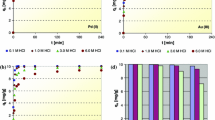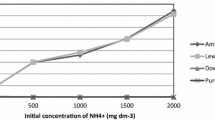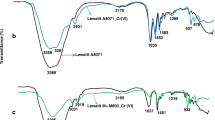Abstract
The aim of the study was to determine properties of selected ion-exchange resins for citric and lactic acids recovery, to define sorption isotherms for these acids at different temperatures (in the range of 20–60°C) and to determine diffusion coefficients inside sorbent particles. A mathematical model of the ion-exchange process in the chromatographic column and its experimental verification is also presented. During investigations 18 types of ion-exchange resins were tested. It was found that weakly basic resins were more suitable for the recovery process than strongly basic ones. The best resin for the separation of citric acid was Amberlite IRA-67 and for lactic acid Amberlite IRA-92. As a result of transient-state sorption experiments diffusion coefficients of the citric acid inside the sorbent particle at different temperatures were obtained. It was found that D p increased with the temperature by two times in the range of 20–60°C, and its value at 60°C was 7.2×10−10 m2/s. The proposed mathematical model was applied to identify bed operation parameters in the column for the needs of the simulated moving bed chromatography method.



Similar content being viewed by others
Abbreviations
- b :
-
Equilibrium constant in Langmuir equation, [dm3/g]
- c :
-
Acid concentration in the liquid phase inside the particle pores, [g/dm3]
- C :
-
Acid concentration in the liquid, [g/dm3]
- D L :
-
Axial dispersion coefficient, [m2/s]
- D p :
-
Intraparticle diffusion coefficient, [m2/s]
- k f :
-
Liquid film mass transfer coefficient, [m/s]
- L :
-
Ion-exchanger bed height, [m]
- q :
-
Acid concentration in the adsorbent phase, [g/dm3]
- R p :
-
Particle radius, [m]
- U :
-
Volumetric flow rate of the feeding solution, [dm3/s]
- V :
-
Volume of the solution, [dm3]
- W :
-
Weight of the wet resin particles, [g]
- ε :
-
The ion-exchanger bed porosity, [-]
- ε p :
-
Particle porosity, [-]
- ν :
-
Linear liquid velocity, [m/s]
- ρ :
-
Apparent density of the wet resin, [g/dm3]
References
Bhandari V, Juvekar V, Patwardhan S (1992) Sorption studies on ion-exchange resins. Ind Eng Chem Res 31:1060–1073
Maeda T, Nakazawa I (1997) Process for separating an organic acids from an organic acid-containing solution. European Patent EP 0483831 A2
Xiong Z (1988) Recovery of bioproducts in China. Adv Appl Microbiol 33:319
Kulprathipanja S (1989) Separation of citric acid from fermentation broth. European Patent EP 324210 B1
Kulprathipanja S, Oroskar A, Preignitz J (1989) Separation of citric acid from fermentation broth with a weakly basic anionic resin adsorbent. US Patent 4851573
Kulprathipanja S (1989) Separation of citric acid from fermentation broth with a strongly basic anionic exchange resin adsorbent. US Patent 4851574
Cao X, Yun H, Koo Y (2002) Recovery of lactic acid by anion exchange resin Amberlite IRA-400. Biochem Eng J 11:189–196
Takatsuji W, Yoshida H (1994) Removal of organic acids from wine by adsorption on weakly basic ion exchangers. Sep Sci Technol 29:1473–1490
Karklins R, Ramina I, Lemba J (1995) Purification and isolation of organic compounds by ion-exchange processes. Latv Kim Z 5:3–17
Dorokhov IN, Gordeev LS, Vinarov A, Leonteva L, Bocharova Yu (1997) Experimental and theoretical study of ion-exchange and crystallization operations in the production of citric acid. Theor Found Chem Eng 31:224
Takatsuji W, Yoshida H (1997) Adsorption of organic acids on weakly basic ion-exchanger: equilibria. Chem Eng Japan 30(3):396
Wang J, Wen X, Zhou D (2000) Production of citric acid from molasses integrated with in-situ product separation by ion-exchange resin adsorption. Biores Technol 75:231–234
Ruthven DM, Ching CB (1989) Counter-current and simulated counter-current adsorption separation processes. Chem Eng Sci 44(5):1011–1038
Nicoud R-M (1999) The separation of optical isomers by simulated moving bed chromatography. Pharmaceut Technol Europ 11:36–44
Takatsuji W, Yoshida H (1998) Adsorption of organic acids on weakly basic ion-exchanger: equilibria for binary systems. AIChE J 44:1216–1221
Resin Selection Guide (1996) Supelco Separation Technologies. Supelco, USA
Acknowledgements
This research was supported by a grant of the Polish Committee for Scientific Research.
Author information
Authors and Affiliations
Corresponding author
Rights and permissions
About this article
Cite this article
Gluszcz, P., Jamroz, T., Sencio, B. et al. Equilibrium and dynamic investigations of organic acids adsorption onto ion-exchange resins. Bioprocess Biosyst Eng 26, 185–190 (2004). https://doi.org/10.1007/s00449-003-0348-7
Received:
Accepted:
Published:
Issue Date:
DOI: https://doi.org/10.1007/s00449-003-0348-7




